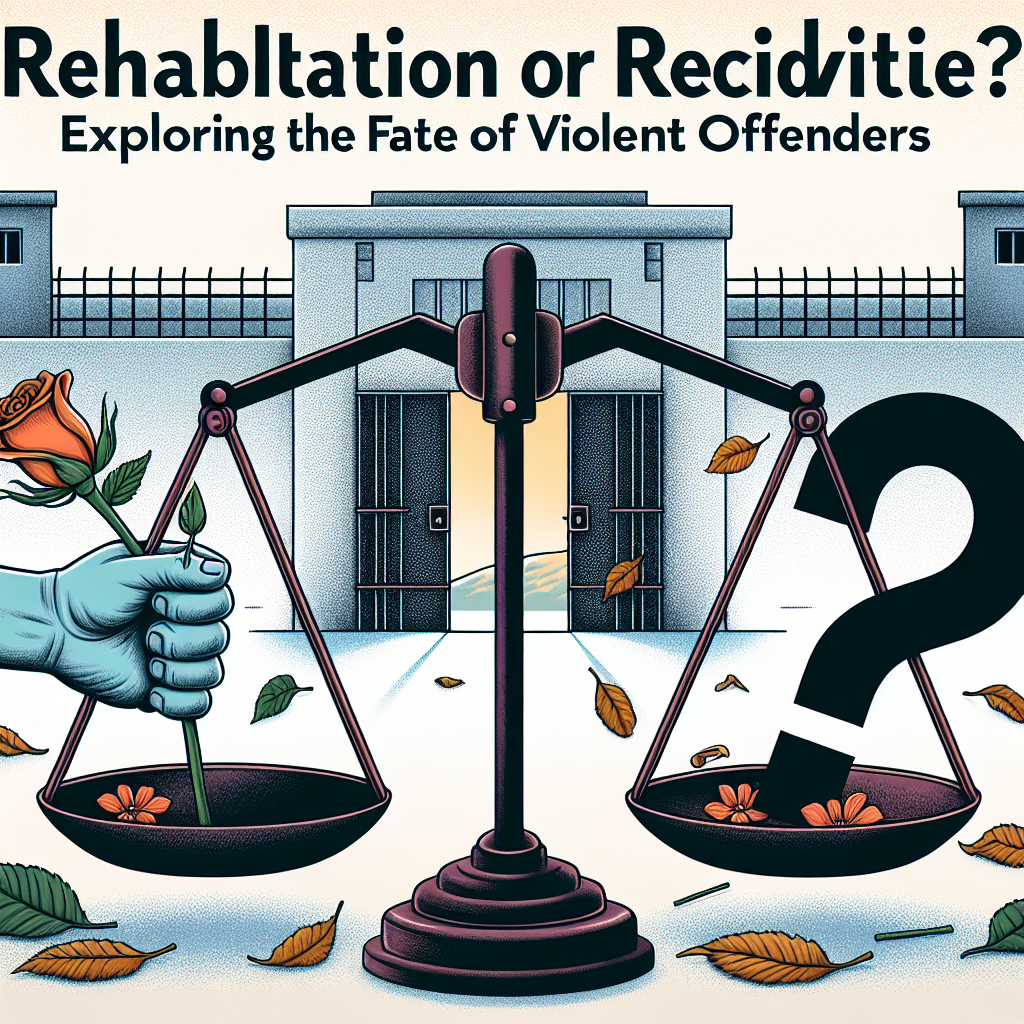
Introduction
In the intricate web of the criminal justice system, few debates are as charged as the question of whether rehabilitation truly works or if violent offenders are destined to reoffend. In a society grappling with high recidivism rates, the tantalizing question remains: can we reform those who have committed acts of violence, or are they bound to repeat their criminal pasts? This article, "Rehabilitation or Recidivism? Exploring the Fate of Violent Offenders," delves into this essential discourse, seeking not just to illuminate the statistics but also to share the powerful stories and transformative possibilities that emerge when we choose rehabilitation over mere punishment.
The State of Recidivism: A Stark Reality
Understanding Recidivism Rates
Recidivism, the tendency of a convicted criminal to reoffend, is dishearteningly common in the realm of violent crime. According to the Bureau of Justice Statistics, approximately 67.8% of released prisoners are rearrested within three years. This alarming figure prompts a crucial examination: what factors contribute to such high recidivism rates?
Demographics and Trends
Table 1: Recidivism Rates by Crime Type
| Crime Type | 1-Year Recidivism | 3-Year Recidivism | 5-Year Recidivism |
|---|---|---|---|
| Violent Crimes | 52% | 67% | 77% |
| Property Crimes | 39% | 55% | 68% |
| Drug Crimes | 48% | 56% | 63% |
These statistics underline a critical concern: violent offenders are less likely to be rehabilitated than those with non-violent criminal histories. Understanding the underlying factors associated with these disheartening trends is vital to our exploration of effective strategies.
The Case for Rehabilitation
The Psychology of Change
When discussing "Rehabilitation or Recidivism? Exploring the Fate of Violent Offenders," it’s essential to understand the psychological underpinnings that affect an individual’s ability to change. Cognitive-behavioral therapy (CBT) is often hailed for its potential to contribute to this transformation, focusing on altering destructive thought patterns. Numerous studies indicate that CBT can reduce recidivism rates, making it a powerful tool in the rehabilitation toolbox.
Case Study: The Success of the Oslo Prison Program
In Norway, the Oslo Prison program has garnered worldwide attention for its emphasis on rehabilitation over punishment. With a recidivism rate of just 20%, significantly lower than that of the U.S., this program provides a compelling case for rehabilitation. By equipping inmates with life skills and educational opportunities, the program fosters genuine reintegration into society.
Analysis
This case study illustrates the power of rehabilitation, suggesting that the right environment, coupled with supportive programs, can lead to notable changes in behavior, even among violent offenders.
Rehabilitation Programs on the Rise
Table 2: Popular Rehabilitation Programs
| Program Name | Focus Area | Recidivism Rate After Completion |
|---|---|---|
| ARISE (Care & Support) | Substance Abuse | 30% |
| The Odyssey Project | Education and Employment | 25% |
| The Violence Prevention Initiative | Anger Management | 22% |
These programs not only highlight the diverse approaches available but also accentuate the promise of rehabilitation as an alternative to punitive measures for violent offenders.
Barriers to Rehabilitation
Stigma and Social Isolation
Even when effective rehabilitation programs are in place, societal stigma poses a significant barrier for violent offenders seeking to reintegrate. According to research by the National Institute of Justice, a hallmark of recidivism is the lack of social support networks. Individuals with criminal histories often face discrimination in housing and employment, reinforcing feelings of isolation and hopelessness.
Case Study: The Struggles of John Doe
Take, for example, the story of John Doe, a once-violent offender who, after participating in a rehabilitation program, earned his GED and secured a job. However, due to his criminal past, potential employers were hesitant to hire him, and his inability to find stable housing ultimately led him back to a life of crime.
Analysis
John’s story emphasizes the significance of community support and the need for societal change. Retooling how we view former offenders can dramatically impact their chances of success.
An In-Depth Look: Addressing the Issues
Implementing Trauma-Informed Care
The intersection between trauma and criminal behavior is undeniable. Many violent offenders have experienced significant trauma, which has contributed to their criminal actions. Trauma-informed care within rehabilitation programs can play a pivotal role in addressing these complexities.
Case Study: The Impact of Trauma-Informed Approaches
The "Healing to Wellness Courts" initiative in various states introduces a trauma-informed lens when dealing with substance abuse and violence. These courts emphasize healing over punishment, significantly reducing recidivism rates among participants.
Analysis
This approach recognizes the emotional and psychological baggage that many offenders carry, promoting a more empathetic, personalized method to rehabilitation.
Policy Proposals: Making Rehabilitation a Priority
Legislative Change
Legislation plays a pivotal role in shaping rehabilitation strategies. Programs like "Second Chance Act" in the U.S. aim to improve outcomes for formerly incarcerated individuals by providing reintegration services and funding for rehabilitation programs. Policymakers must prioritize such initiatives to design a system where rehabilitation takes precedence over punishment.
Community Engagement and Support Systems
Building robust community support systems is essential to bridge the gap between rehabilitation and successful reintegration. Initiatives that connect former offenders with mentors or peer-support groups can significantly reduce feelings of isolation and improve outcomes.
The Role of Employers in Reintegration
Creating Opportunities
Employers can play a transformative role in the rehabilitation journey of violent offenders. Companies with policies that encourage hiring individuals with criminal backgrounds send a powerful message of support and second chances.
Case Study: The Success of the "Ban the Box" Movement
The "Ban the Box" movement, which aims to remove the criminal history question from job applications, has had a positive impact on hiring practices. Companies that adopt this policy often report not only a more diverse workforce but also improved community relations.
Analysis
By fostering a culture of acceptance, businesses can contribute significantly to reducing recidivism rates.
Conclusion
The question of "Rehabilitation or Recidivism? Exploring the Fate of Violent Offenders" is one that demands our attention and empathy. Through effective rehabilitation programs, supportive communities, and conscious legislative changes, we can shift the narrative from mere punishment to genuine reform. The potential for change exists, and it is incumbent upon us as a society to harness it.
We have witnessed through the myriad case studies and data that rehabilitation is not only possible—it is essential. For those entwined in the criminal justice system, a second chance can mean an entirely new direction. Let us recognize the humanity in every offender and open our arms to the transformative power of rehabilitation.
FAQs
1. What is recidivism, and why is it a concern?
Recidivism refers to the tendency of a convicted criminal to reoffend. It is a concern because high recidivism rates indicate that our current systems of justice may not be effectively rehabilitating offenders.
2. What are the most effective rehabilitation programs for violent offenders?
Programs such as cognitive-behavioral therapy, trauma-informed care, and vocational training are considered effective in reducing recidivism rates among violent offenders.
3. How does trauma relate to violent offending?
Many violent offenders have experienced significant trauma, which can contribute to their criminal behavior. Addressing this trauma through specific therapeutic programs can help reduce recidivism.
4. What role do employers play in the rehabilitation process?
Employers can help by offering job opportunities to formerly incarcerated individuals, fostering a sense of community support and increasing the chances of successful reintegration.
5. How can society better support the rehabilitation of violent offenders?
Society can support rehabilitation by advocating for legislative changes, creating inclusive policies like "Ban the Box," and promoting community programs that offer mentorship and support systems.
In “Rehabilitation or Recidivism? Exploring the Fate of Violent Offenders,” we have examined the critical interplay between rehabilitation and the likelihood of reoffending. It is a complex discourse that invites us to reflect on the systems we uphold and the compassion we extend. As we move forward, let us advocate for structural changes that embrace rehabilitation and foster environments of support and acceptance.















